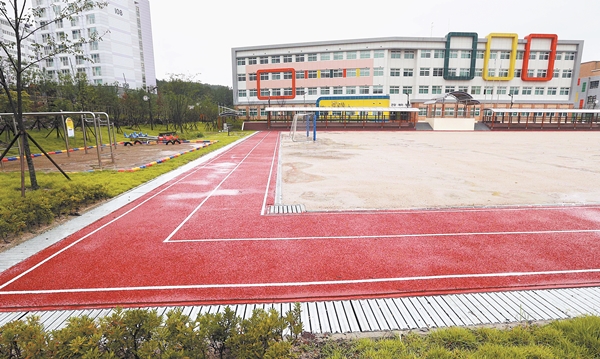Many schools lack outdoor space

The schoolyard at Oesol Elementary in Ulsan, is shaped like a rectangle to maximize outdoor space. Most students find the outline of the course to be an inconvenience. By Song Bong-geun
Surrounding the yard is a running track that is also in the form of a rectangle.
Unlike conventional round tracks, the corners in the course cause many children to bump into each other while running. “When I run at full speed, I often bump into other people,” said a first-grade boy surnamed Kim. “I hope the school will make the sports ground round.”
But the Ulsan elementary school is just one of a legion of schools lacking the space to build a decent sports yard.
“The school has a limited area,” said Lee Jung-gyu, the director of the school facility division in the Ulsan Metropolitan Office of Education. “Schools are required to build green spaces, so we decided to make the school yard smaller.”
A number of schools nationwide lack the space for playgrounds, according to a report by Saenuri Rep. Lee No-keun.
Among 11,446 schools surveyed, only 31.5 percent, or 3,600 elementary, middle and high schools, have running tracks that stretch 100 meters (109 yards) in a single line.
“Schools need to foster well-rounded talent,” Lee continued. “I doubt that children can play in a cramped space where they can’t even sprint 100 meters.”
Physical education courses in Korea are often put aside for major subjects like math, English and Korean, and some schools consider gym class part of supplementary study sessions.
The Ministry of Education recently sought to attach more importance to physical education for the country’s students.
Starting next year, it will expand the time dedicated to physical education classes to 10 hours per week throughout three years of high school.
All high schools, including foreign language and science schools, must comply with the new requirements.
Under the law, elementary, middle and high schools must be equipped with sports facilities measuring more than 3,800 square meters (4,544 square yards) when the number of students exceeds 1,000.
However, the law doesn’t necessarily mean that school yards will be expanded, as sports facilities usually also include an institution’s auditorium, indoor gymnasium and even drinking fountain. Some schools also prefer to have wider indoor facilities. “When we talk about auditoriums and other facilities, we can expand area by raising the floors,” said Kim Seung-gyum, a researcher at the Education Ministry. “But when it comes to the school yard, schools must secure a certain amount of land. Schools located in the city, in particular, will find it hard to secure adequate space because of limited budget and the limited space available.”
BY KIM KI-HWAN [ejpark@joongang.co.kr]










with the Korea JoongAng Daily
To write comments, please log in to one of the accounts.
Standards Board Policy (0/250자)